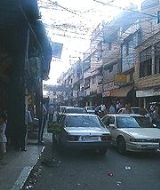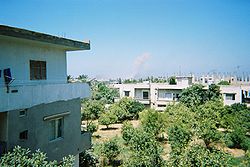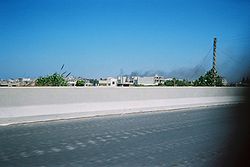
Nahr al-Bared
Encyclopedia
Nahr al-Bared is a Palestinian refugee camp in northern Lebanon
Lebanon
Lebanon , officially the Republic of LebanonRepublic of Lebanon is the most common term used by Lebanese government agencies. The term Lebanese Republic, a literal translation of the official Arabic and French names that is not used in today's world. Arabic is the most common language spoken among...
, 16 km from the city of Tripoli
Tripoli, Lebanon
Tripoli is the largest city in northern Lebanon and the second-largest city in Lebanon. Situated 85 km north of the capital Beirut, Tripoli is the capital of the North Governorate and the Tripoli District. Geographically located on the east of the Mediterranean, the city's history dates back...
. Some 30,000 displaced Palestinians and their descendents live in and around the camp, which was named after the river that runs south of the camp. Under the terms of the 1969 Cairo Agreement
Cairo agreement
The Cairo agreement or Cairo accord was an agreement reached on 2 November 1969 during talks between Yassir Arafat and the Lebanese army commander General Emile Bustani...
, the Lebanese Army does not conventionally enter the Palestinian camps, and internal security is provided by Palestinian factions.
The camp was established in December 1949 by the League of Red Cross Societies in order to accommodate the Palestinian refugees suffering from the difficult winter conditions in the Beqaa Valley
Beqaa Valley
The Beqaa Valley is a fertile valley in east Lebanon. For the Romans, the Beqaa Valley was a major agricultural source, and today it remains Lebanon’s most important farming region...
and the suburbs of Tripoli. The camp was established outside any major Lebanese towns or settlements, which left Nahr al-Bared more isolated from the Lebanese society than many of the other camps in Lebanon. Despite this, due to its position on the main road to Syria
Syria
Syria , officially the Syrian Arab Republic , is a country in Western Asia, bordering Lebanon and the Mediterranean Sea to the West, Turkey to the north, Iraq to the east, Jordan to the south, and Israel to the southwest....
and its proximity to the Syrian border, Nahr al-Bared grew to be a central commercial hub for the local Lebanese of the Akkar region.
Layout of the camp
Nahr al-Bared is located directly on the MediterraneanMediterranean Sea
The Mediterranean Sea is a sea connected to the Atlantic Ocean surrounded by the Mediterranean region and almost completely enclosed by land: on the north by Anatolia and Europe, on the south by North Africa, and on the east by the Levant...
. It is made up of the "official" or "old" camp and the "unofficial" or "new" camp. The "old" camp is roughly 0.2km² and is under the responsibility of UNRWA. The "new" camp extends mainly to the north of the old camp, but also to lesser degrees to the east and south. It is less densely populated and many wealthier families have built their homes there in recent years.
The camp is oblong shaped with the main road running straight through it (South to North), and the Souq running east to west. The different sectors of the camp are named after areas of what is now the northern Galilee
Galilee
Galilee , is a large region in northern Israel which overlaps with much of the administrative North District of the country. Traditionally divided into Upper Galilee , Lower Galilee , and Western Galilee , extending from Dan to the north, at the base of Mount Hermon, along Mount Lebanon to the...
region : Safourieh, Sasa, Safad, etc. Other sectors are more commonly known by the origins of the families living there: e.g. the "Naseem" area where families originally from Acre
Acre
The acre is a unit of area in a number of different systems, including the imperial and U.S. customary systems. The most commonly used acres today are the international acre and, in the United States, the survey acre. The most common use of the acre is to measure tracts of land.The acre is related...
, Canada
Canada
Canada is a North American country consisting of ten provinces and three territories. Located in the northern part of the continent, it extends from the Atlantic Ocean in the east to the Pacific Ocean in the west, and northward into the Arctic Ocean...
or Morocco who had moved to Palestine in the 1930s now live.
2007 conflict



Fatah al-Islam
Fatah al-Islam, is a radical Sunni Islamist group that formed in November 2006 in a Palestinian refugee camp, located in Lebanon. It has been described as a militant jihadist movement that draws inspiration from al-Qaeda...
militants accused of taking part in a bank robbery earlier that day were hiding. The ISF attacked the building early on Sunday May 20 2007, unleashing a day long battle between the ISF and Fatah al-Islam militants on 200 Street, Tripoli. As a response, members of Fatah al-Islam in Nahr al-Bared Camp (16 km from Tripoli) attacked an army checkpoint, killing several soldiers in their sleep. The army immediately responded by shelling the camp.
The camp became the centre of the fighting between the Lebanese Army and Fatah al-Islam. It sustained heavy shelling while under siege. Most of the inhabitants fled to the nearby Beddawi Palestinian refugee camp (doubling that camps population) or further south to Tripoli, Beirut and Saida. The last civilians (25 women and 38 children, the families of Fatah al-Islam members) were evacuated from the camp on Friday August 24, 2007.
The conflict between the Lebanese Army and Fatah al-Islam ended on Sunday September 2, 2007 with the Lebanese Army taking full control of the camp after eliminating the remaining terrorist pockets http://www.reuters.com/article/topNews/idUSL0261343920070902.
The United Nations Relief and Works Agency, or UNRWA, charged with the care of the Palestinians, struggled to contain the unprecedented humanitarian crisis. In the meantime, most of the displaced refugees waited in improvised shelters in Beddawi camp and elsewhere for a sustainable solution to arrive (http://www.pulitzercenter.org/openitem.cfm?id=814).
Nahr al-Bared was also home to the largest market in northern Lebanon; many Lebanese relied on the tax-free goods and black market prices to keep the cost of living down in a country with current inflation at 5.6%. The demise of Nahr al-Bared was a devastating blow to the local economy (http://www.pulitzercenter.org/openitem.cfm?id=835). The failure of the international community, and Arab states in particular, to fund an emergency humanitarian appeal for Nahr al-Bared means life for refugees living there is set to get harder. .
External links
- Nahr al-Bared, articles from UNWRA
- Photo slideshow by UN IRIN news of ruined Nahr al-Bared camp
- Nahr Al Bared Pictures
- Nahr Al Bared Camp Official Site
- Nahr Al Bared Camp Blog
- Nahr al-Bared: Refuge in Ruin, a reporting project from the Pulitzer Center on Crisis Reporting
- In Video: Palestinian Refugees return to Nahr al-Bared, Don Duncan and Andrea de Marco, the Christian Science Monitor, March 4 2008
- In Pictures: Palestinians return to ruined Lebanese camp
- Fall of Nahr al-Bared devastates surrounding economy: Marketplace radio segment by Don Duncan, April 11, 2008
- Refugees Return to Camp, Don Duncan, The Washington Times, March 25, 2008
- Lebanese struggle with broken economy, Don Duncan, The San Francisco Chronicle, March 23, 2008
- As Rebuilding Begins at Lebanon's Nahr al-Bared, Displaced Refugees Eager to Return, William Wheeler and Don Duncan, World Politics review, 11 Mar 2008
- Palestinians' bittersweet homecoming in Lebanon, by William Wheeler and Don Duncan, The Christian Science Monitor, March 5, 2008
- "LPDC"

